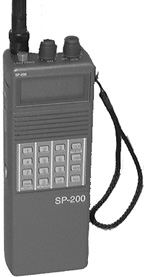
by Gary Picou
From the all-good-things-must-end file, bargains sometimes arent bargains forever. To wit, since we last examined handheld transceivers-see Aviation Consumer, September 2001-Sportys JD-200 VHF portable has been phased out. Although this radio lacked top-end performance and features, the fact that it was inexpensive still made it a good value.
The good news, however, is that even though the JD-200 is gone, Sportys hasnt given up its lock on the low-end of the VHF handheld market. The JD-200 has been replaced by the SP-200 and we found it to be a similarly good value at the bargain end of the spectrum. At $275, its the cheapest handheld on the market. And although a bit limited in featureset, its still a good value, with some interesting perks besides.
In our tests, performance of the SP-200 was almost identical to the JD-200, except it has about 15 percent more transmit power. That puts it slightly higher than the other VHF handheld units weve tested, right around .8 watts of carrier power, with a fresh set of alkaline batteries. These have better storage and output current capability than nicads, making them the top choice for a back-up radio that wont see much use.
The SP-200 has one feature thats common on panel-mount comms: a recall or flip/flop function. We wonder why it hasnt been adopted earlier. We suppose the designers at Icom and Yaesu arent as used to general aviation avionics as is Sportys.
The other new feature, which is specious for use in the U.S., is 8.22 kHz channel spacing. Remember the great hoo-haa when the FAA and FCC demanded that we switch to those 720-channel radios? These have 25 kHz spacing. Today, we still see some old radios, because aviators do love to hang on to vintage avionics. But in Europe, 8.33 kHz channeling is a requirement for large aircraft and for small aircraft flying IFR. Less expansive, congested airspace means more frequencies trying to share spectrum. Frankly, even in Europe, the implementation of 8.33 kHz is at a point where it would be a necessity in the next generation of handheld radios. The FAA believes that 8.33 kHz spacing, with more than 2200 frequencies available, will not solve spectrum overcrowding any more than just adding more, smaller, seats to an airliner will decrease airport crowding. Their official policy touts a transition to a digital data radio. Digital data- VDL-will make any handheld obsolete. But we digress.
If youre looking for a good back-up portable comm suitable for picking up clearances and monitoring the tower frequency while youre having a burger in the airport greasy spoon, the SP-200 is a good value, probably the best in a field of a dozen radios-thats right, there are that many to choose from-if price is main driver and only occasional use is contemplated. The SP-200 has essential features-comm and nav bands we’ll covered, external power and audio, backlit screen and keyboard, simple operating logic and duplex comm.
If every feature in the book is your wont, then the Icom A-23 still leads the pack in both high price and overall performance. Typically, it sells for about $450 or about $175 more than the SP-200. If youre a gadget dweeb, the extra money may be worth it. If you just want a decent radio, cheap, the SP-200 will meet that requirement.
———-
-Gary Picou works for PS Engineering, an intercom maker. Hes an occasional contributor to Aviation Consumer.


